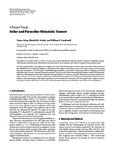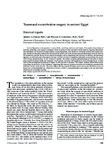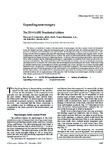|
|
Creator | Title | Description | Subject | Date |
| 1 |
 |
Kestle, John R. W. | Natural history of cerebral cavernous malformations | To determine the natural history of brain cavernous malformations, the authors entered patients referred to their center into a prospective registry between 1987 and 1993. All patients underwent magnetic resonance imaging, which showed the typical appearance of this lesion, and conservative manageme... | Cavernous malformation; Vascular malformation; Seizure | 1995 |
| 2 |
 |
Kestle, John R. W. | Simple risk predictions for arteriovenous malformation hemorrhage | WE PRESENT A simple risk prediction formula for arteriovenous malformation hemorrhage. Natural history studies have shown an annual risk of hemorrhage of 2 to 4% for patients with brain arteriovenous malformations. Although decision analysis programs and biostatistical models are available to predic... | Arteriovenous malformation; Hemorrhage risk; Prediction formula | 1995 |
| 3 |
 |
Couldwell, William T. | Comment on Nugent, G. R.: Targeting the ventral lateral nucleus of the thalamus: a stereotactic vignette | Dr. Nugent provides a fascinating personal account of his early experience with stereotactic surgery for movement disorders. I was especially pleased to read the positive comments regarding the personal interactions with and innovations of Irving Cooper, a neurosurgeon who was derided by his peers b... | Stereotactic surgery; Stereotaxis | 2006 |
| 4 |
 |
Garber, Sarah | Spinal arteriovenous fistulas in children with hereditary hemorrhagic telangiectasia: report of 2 cases | Hereditary hemorrhagic telangiectasia (HHT) is an autosomal dominant angiodysplasia with high penetrance and variable expression. The manifestations of HHT are often age related, and spinal arteriovenous fistula (AVF) may be the initial presentation of HHT in young children. Because spinal AVFs are... | | 2012-01-01 |
| 5 |
 |
Couldwell, William T. | Intracranial hypotension in the setting of concurrent perineural cyst rupture and subarachnoid hemorrhage | Although most patients with intracranial hypotension typically present with headaches, the rest of the clinical spectrum is characteristically non-specific and often quite variable. In a patient with concurrent pathologies that can produce a similar clinical picture, a high index of suspicion must b... | | 2013-01-01 |
| 6 |
 |
Couldwell, William T. | Norman Dott, Gerard Guiot, and Jules Hardy: key players in the resurrection of transsphenoidal surgery | Developed over a century ago, the introduction of the transsphenoidal approach to access lesions of the pituitary gland and sella turcica has transformed the field of neurosurgery, largely due to the work of Oskar Hirsch and Harvey Cushing. Furthermore, its use and modification in the early 1900s wa... | | 2012-01-01 |
| 7 |
 |
Couldwell, William T.; Nelson, Don Harry | Nelson syndrome: historical perspectives and current concepts | The appearance of an adrenocorticotropic hormone (ACTH)-producing tumor after bilateral adrenalectomy for Cushing disease was first described by Nelson in 1958. The syndrome that now bears his name was characterized by hyperpigmentation, a sellar mass, and increased plasma ACTH levels. The treatment... | | 2007-01-01 |
| 8 |
 |
Couldwell, William T. | Sellar and parasellar metastatic tumors | The sellar and parasellar (SPS) region is a complex area rich in vital neurovascular structures a first manifestation of a systemic malignancy. Metastases to this region are rare; breast cancer is the most common source among those that metastasize to the SPS region. Ophthalmoplegia, headache, retro... | | 2012-01-01 |
| 9 |
 |
Couldwell, William T. | Development of neurosurgery in Southern California and the Los Angeles County/University of Southern California Medical Center | The Los Angeles County General Hospital has played an integral role in the development of medicine and neurosurgery in Southern California. From its fledgling beginnings, the University of Southern California School of Medicine has been closely affiliated with the hospital, providing the predomina... | Historical vignette; Los Angeles County General Hospital; University of Southern California School of Medicine; Neurosurgical history | 1993 |
| 10 |
 |
Kestle, John R. W. | Reduction of hemorrhage risk after stereotactic radiosurgery for cavernous malformations | The benefits of radiosurgery for cavernous malformations are difficult to assess because of the unclear natural history of this vascular lesion, the inability to image malformation vessels, and the lack of an imaging technique that defines "cure." The authors selected for radiosurgery 47 patients w... | Cavernous malformation; Gamma knife; Stereotactic radiosurgery | 1995 |
| 11 |
 |
Couldwell, William T. | Transnasal excerebration surgery in ancient Egypt: Historical vignette | Ancient Egyptians were pioneers in many fields, including medicine and surgery. Our modern knowledge of anatomy, pathology, and surgical techniques stems from discoveries and observations made by Egyptian physicians and embalmers. In the realm of neurosurgery, ancient Egyptians were the first to elu... | | 2012-01-01 |
| 12 |
 |
Couldwell, William T. | Resolution of an anterior-inferior cerebellar artery feeding aneurysm with the treatment of a transverse-sigmoid dural arteriovenous fistula | The authors describe a 27-year old man who developed an unruptured anterior-inferior cerebellar artery feeding aneurysm from a transverse-sigmoid dAVF and its subsequent resolution with the treatment of the dAVF. The patient, with a known history of left transverse and sigmoid sinus thrombosis, pres... | Aneurysms; Dural Arteriovenous Fistulas; Endovascular therapy; Surgery | 2007 |
| 13 |
 |
Couldwell, William T. | Expanding neurosurgery | The history of medicine is replete with innovations in neurosurgery that have spurred further developments across the medical spectrum. Surgeons treating pathologies in the head and spine have broken ground with new approaches, techniques, and technologies since ancient times. Neurosurgeons occupy a... | | 2014-01-01 |
| 14 |
 |
Couldwell, William T. | History and evolution of transsphenoidal surgery | Initial attempts at transcranial approaches to the pituitary gland in the late 1800s and early 1900s resulted in a mortality rate that was generally considered prohibitive. Schloffer suggested the use of a transsphenoidal route as a safer, alternative approach to the sella turcica. He reported the f... | Neurosurgical history; Transsphenoidal surgery; Pituitary tumor | 2001 |
| 15 |
 |
Couldwell, William T. | William Osler at McGill University: the baby professor and his early contributions to neurosurgery | Between 1870 and 1884, as both a medical student and a member of the faculty, Sir William Osler performed approximately 1000 postmortem examinations at McGill University in Montreal. He conducted 786 of these examinations during his 7 years (1877-1884) of service as a pathologist at the M were caref... | | 2004-10 |
| 16 |
 |
Kestle, John R. W. | Sporadic osteochondroma of the cervical spine | Osteochondroma is the most common benign tumor of bone, but axial skeleton involvement is uncommon and usually indicates a hereditary cause such as osteochondromatosis (hereditary multiple exostosis). 1 Approximately 7% of hereditary osteochondromas occur along the vertebral column, which is double... | | 2006 |
| 17 |
 |
Schmidt, Meic H. | Diffuse large B-cell lymphoma presenting as a sacral tumor | Primary lymphomas of the sacrum are rare tumors, reported only in a few cases in the literature. The authors describe two patients with diffuse large B-cell lymphomas presenting as a sacral tumor. In the first case a 52-year-old man presented with progressive back pain, bilateral radicular pain, an... | B-cell lymphoma; Sacral tumor | 2003 |
| 18 |
 |
Couldwell, William T.; Schmidt, Richard H.; Salzman, Karen L.; Chin, Steven S. | Glioblastoma multiforme of the pineal region | Glioblastoma multiforme (GBMs) tumors are exceedingly rare tumors in the pineal region. We present three cases in which patients presented with a pineal/posterior third ventricular region mass and review all the previously reported cases in the literature. Pineal region GBM seems to be a very aggre... | Glioblastoma multiforme; Hydrocephalus; Leptomeningeal dissemination; Malignant glioma; Perinaud's syndrome; Pineal region; Spinal metastases | 2006 |
| 19 |
 |
Dailey, Andrew T. | Magnetic resonance neurography for cervical radiculopathy: a preliminary report | MAGNETIC RESONANCE NEUROGRAPHY was used to directly image cervical spinal nerves in patients with clinical and radiographic evidence of cervical radiculopathy. A magnetic resonance imaging phased-array coil system was used to obtain high-resolution coronal T1-weighted spin echo, coronal/axial T2-wei... | | 1996 |
| 20 |
 |
Dailey, Andrew T. | Guideline update for the performance of fusion procedures for degenerative disease of the lumbar spine. Part 14: Brace therapy as an adjunct to or substitute for lumbar fusion | The utilization of orthotic devices for lumbar degenerative disease has been justified from both a prognostic and therapeutic perspective. As a prognostic tool, bracing is applied prior to surgery to determine if immobilization of the spine leads to symptomatic relief and thus justify the performanc... | | 2014-01-01 |
| 21 |
 |
Couldwell, William T.; Jensen, Randy L.; Jensen, Elizabeth M. | Development of contrast enhancement after long-term observation of a dysembryoplastic neuroepithelial tumor | Dysembryoplastic neuroepithelial tumors (DNET) are usually benign lesions that arise in cortical regions and are discovered after new onset of seizure. These lesions have many different imaging characteristics. We report a patient with a presumed low-grade medial temporal lobe lesion that was follow... | Brain tumor; Dysembryoplastic neuroepithelial tumors; DNET; Imaging; Seizures | 2006 |
| 22 |
 |
Couldwell, William T. | Medical and surgical management of microprolactinoma | A recent report by Colao et al. [1] indicates that a significant proportion of patients harboring prolactinomas treated with cabergoline will have persistence of remission of hyperprolactinemia following withdrawal of the drug. The prolactin and tumor control rates in the study suggest that medical ... | Microprolactinoma; Prolactinoma; Cabergolene | 2004 |
| 23 |
 |
Couldwell, William T. | Pituitary gland metastasis from adenocarcinoma of the prostate | A case of prostatic carcinoma metastasis to the pituitary gland is reported. The presentation and rarity of such a lesion is addressed. The literature review yielded only isolated case reports of symptomatic brain metastases unassociated with bone disease from adenocarcinoma of the prostate. The man... | Prostate; Pituitary gland; Adenocarcinoma; Metastasis; Transsphenoidal surgery | 1989 |
| 24 |
 |
Kestle, John R. W.; Brockmeyer, Douglas Lee | Optic pathway gliomas: a review | Optic pathway gliomas represent approximately 3-5% of childhood intracranial tumors. They usually occur in children during the first decade of life and are seen in 11-30% of patients with neurofibromatosis Type 1 (NF1). Although these tumors are typically low-grade gliomas, the clinical course and n... | Optic pathway glioma; Hypothalamus glioma; Neurofibromatosis Type 1 | 2007 |
| 25 |
 |
Couldwell, William T. | Irving S. Cooper and the early surgical management of movement disorders | Irving S. Cooper was a pioneer in the field of functional neurosurgery. During his very productive and controversial career, he proposed the surgical treatment of Parkinson disease (PD) by ligating the anterior choroidal artery to control tremor and rigidity. Subsequently, he developed seminal techn... | Functional neurosurgery; Movement disorder; Video | 2001 |

























